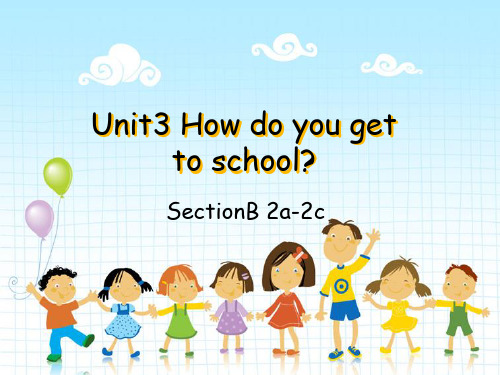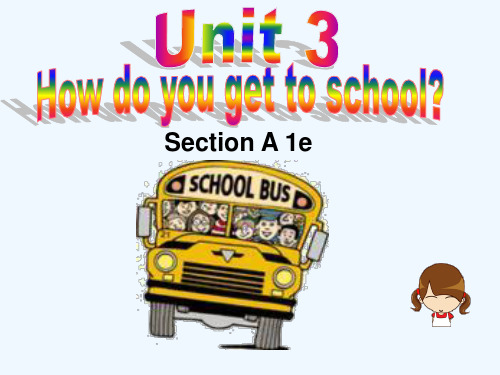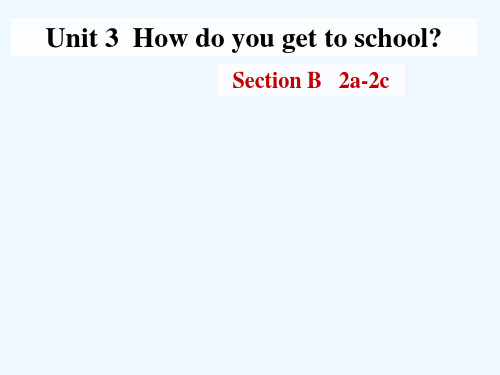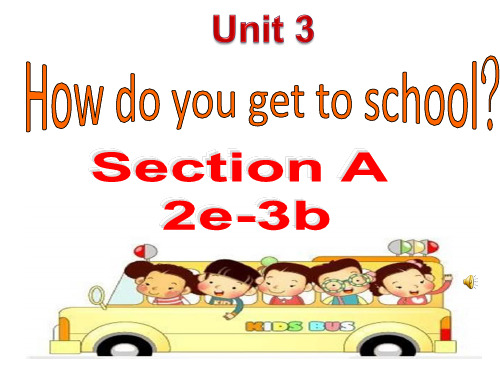七年级下册unit3 how do you go to schoolSection A 1
- 格式:ppt
- 大小:4.99 MB
- 文档页数:37






Unit 3 how do you get to school?一、本单元重点知识点总结1.get to school 到校2.take the subway 乘地铁3.take the train 坐火车4.leave for 到...地方去;离开去某地5.take…to…把...带到6. most students 大多数学生7. depend on 依赖...;决定于...8.from…to…从...到...9.think of 想到...;想起...10.ride bikes 骑自行车11.in other parts of the world 在世界的其他地方12. how far 多远13.take the train to school 乘火车去上学14.in places 在一些地方15.go to school by boat乘船去上学16.on the school bus乘坐校车17.be different from和...不同18.worry about 担忧...;焦虑...;担心...19. take sb. some time to do sth. 花费某人某些时间去做某事20.in common 共有,相同21.travel abroad 去国外旅游22. go down to延续至;走下去…23. most of大多数的24. some of一些25. bus station汽车站26. bus ride乘汽车之行27. come back回来28. by boat乘坐小船29. walk to school步行去上学30. have to不得不二、重点知识点详解1. How do you get to school?how是疑问副词,意为“如何,怎样,用什么手段”。
本句为how引导的特殊疑问句,用以询问交通工具。
☞回答:①take + a/the + 交通工具,“乘...去某地”。
Unit 3 How do you go to school?词汇列表Group 1交通方式train/treɪn/n.火车subway/ˈsʌbweɪ/n.地铁take the subway乘地铁ride/raɪd/v.骑n.旅程by bike骑自行车stop/stɒp/n.车站;停车drive/draɪv/v.开车cross/krɒs/v.横过;越过river/ˈrɪvə(r)/n.河;江bridge/brɪdʒ/n.桥boat/bəʊt/n.小船Group 2 询问路程far/fɑː(r)/adj.&adv.远;远的live/lɪv/v.居住;生活between/bɪˈtwiːn/prep.介于……之间sixty/ˈsɪksti/num.六十seventy/ˈsevnti/num.七十eighty/ˈeɪti/num.八十ninety/ˈnaɪnti/n.分钟hundred/ˈhʌndrəd/n.一百minute/ˈmɪnɪt/n.分钟kilometer/ˈkɪləʊˌmiːtə/n.千米;公里Group 3 乡村生活every/ˈevri/adj.每一;每个every day每天think of认为;想起many/ˈmeni/adj&pron.许多village/ˈvɪlɪdʒ/n.村庄;村镇afraid/əˈfreɪd/adj.害怕;畏惧leave/liːv/v.离开dream/driːm/n.梦想v.做梦true/truː/adj.真的come true实现;成为现实词汇精讲1. livev.居住;生活(1)live in +地点名词/live +地点副词居住在某地(2)live with sb.和某人住在一起(3)live a ... life 过着一种……的生活e.g. He lives in a small village with his grandparents.练习1:She _____________(live) in her grandmothers’ home now.练习2:Tom wants to live ___________ Shanghai.练习3:Sometimes Mary lives _____________ her grandmother.2. hundred & hundreds of(1)hundred num.一百。
Unit3 How do you get to school?Section B 1 (2a-2c)一、教学目标:1. 语言知识目标:1) 能掌握以下单词:cross, river, many, village, villager, between, bridge, boat, ropeway, afraid, dream, 2) 掌握以下句型:It is easy to get to school.There is no bridge and the river runs too quickly for boats.One 11-year-old boy, Liangliang, crosses the river every school day.He’s like a father to me.3) 阅读短文,获取相关信息的能力。
2. 情感态度价值观目标:了解乡村学生上学的交通方式,启发学生珍惜自己的美好生活,鼓励学生努力学习。
二、教学重难点通过进行听、说、读、写的训练,来提高学生们综合运用所学知识的能力。
三、教学过程(一)复习和导入用句型“Do/Dose they/he/she go to school ….?”猜猜PPT上人物的上学方式。
(二)词汇学习通过展示图片,学习新词汇,为阅读文章做好准备。
(三)文章学习1. 阅读前:Look at the picture and title(题目) below. Guess(猜) what the passage(文章) is about.2.阅读中:(1)Fast readingHow do the students in the village go to school?Why do they go to school like this?Does the boy like this school? Why?What’s the villagers’ dream? Do you think their dream can come true? Why or why not?(2)Careful readingRead the passage again. Complete the sentences with the words from the passage. For the students in the village, it is ________ to get to the school.They have to cross a very _____ river between their school and the village.They cannot go by boat because the river runs too _________.It is not easy to cross the river on a ropeway, but the boy is not _______.The students and villagers want to have a bridge. Can their dream come _____? 3.阅读后听课文,划难点,讲解知识点。